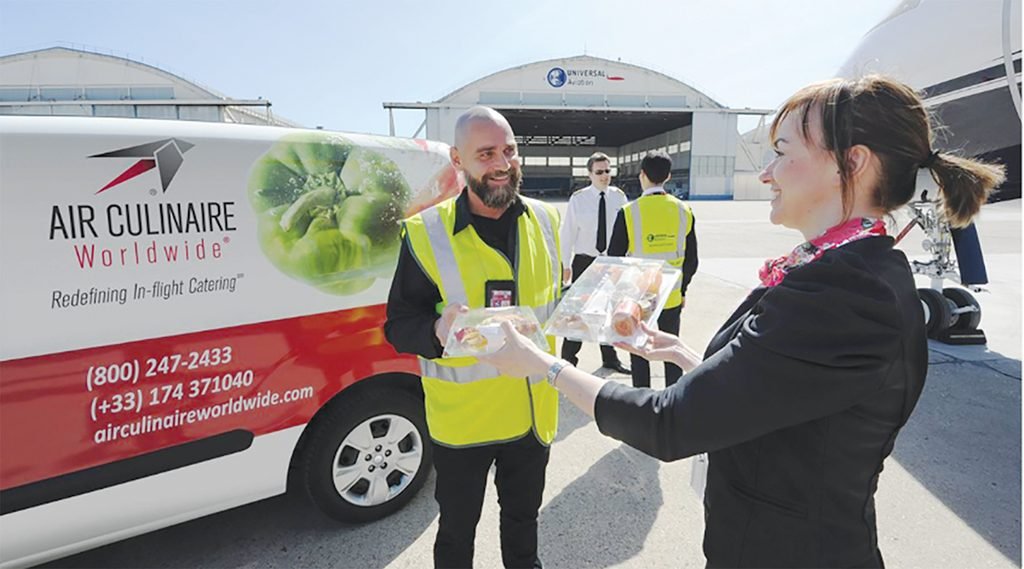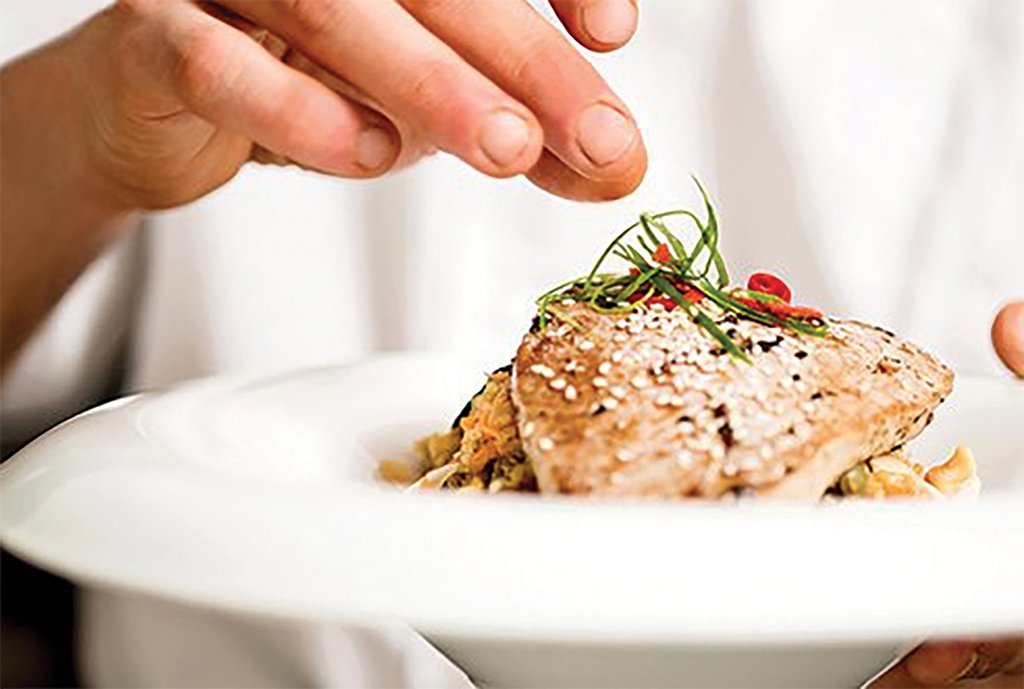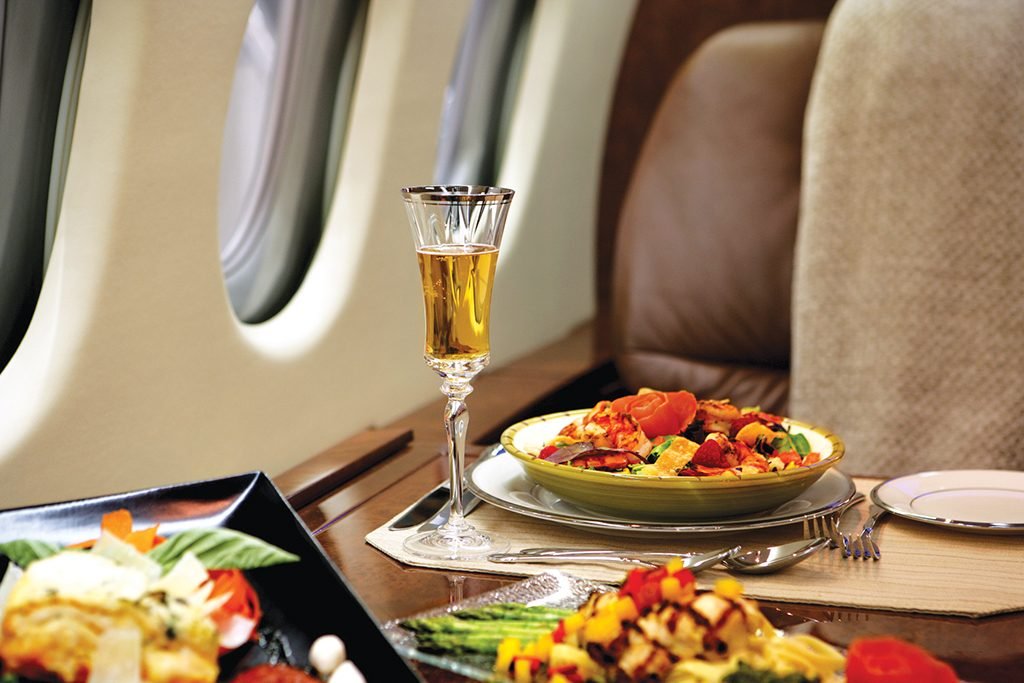Years ago, Learjet Corp. produced a promotional film called “It’s All About Time” that emphasized the travel hours that could be saved by using a business aircraft, in large part because of its on-demand dispatch flexibility. Business jets afforded premium level transportation and commanded premium level prices.
Discerning passengers aboard such aircraft also expected premium-level accommodations and cabin services, including food and beverage choices that were well above what commercial airlines delivered. Customer demand spawned the new specialty industry of on-demand inflight catering, companies that offered quick response, exceptional quality and plane-side delivery convenience. Premium-level catering commanded premium-level prices.
While clients might balk at the tab, such caterers’ costs can be considerably higher than many people realize.

Credit: Air Culinaire Worldwide
“You want [déclassé] prices? Expect [déclassé] quality. You want Ritz-Carlton or W Hotel quality? Expect premium prices,” says Paula Kraft, founding partner of the DaVinci Inflight Training Institute in Fort Lauderdale, Florida. “Just look at what it takes to maintain a minimal inflight catering kitchen. You need an executive chef, a sous-chef, a shopper and a driver. You have to be on call 24/7, so that if you get a 2:00 a.m. call, the order is ready for a 6:00 a.m. plane-side delivery.”
She should know. She founded Tastefully Yours Catering, a long-time, well-respected caterer based at Atlanta’s DeKalb-Peachtree Airport (KPDK) and regularly writes about catering for various publications. She’s also active in the International Caterers Association, the International Inflight Food Service Association and she is a board member of Women in Corporate Aviation, along with being the past chair of the NBAA’s Flight Attendant Advisory Committee.
“We’re in the service industry,” says Kraft. She notes that top-flight catering demands all fresh ingredients, all homemade soups, sauces and stocks. Perishables, such as dairy products and eggs, milk, yogurt, butter, cheese and ice cream, all have short shelf lives, even at continuous 38F to 40F temperatures. Once the seal is broken on the container, dairy products start to absorb flavors from other foods in the refrigerator. Fresh meat and poultry age quickly in cold storage. They’re spoiled in minutes or less than an hour at room temperature. Most fruits and vegetables should be stored separately at 45F to 50F. Broccoli is an exception, as it needs colder storage.
Seafood lasts only a few hours, a few days at most, even when stored at an ideal 34F temperature. Live shellfish, such as crabs, lobsters and prawns, should be stored at 34F to 38F. The standard for freshness in business-jet catering is the same as at three-star Michelin restaurants.
Kraft says Rudy’s Inflight Catering and Air Culinaire are two top-tier food and beverage suppliers that provide good value for the dollar, even if their prices can be higher than those of some competitors. Air Gourmet and Silver Lining round out the top four inflight catering companies, says Susan Friedenberg, founder of Corporate Flight Attendant Training & Consulting and former member of the NBAA Flight Attendant Advisory Committee.

If you want Ritz-Carlton or W Hotel quality, expect premium prices from your caterers. Credit: iStockphoto
While caterers attempt to stock a wide variety of menu items, costs for certain foods vary with seasonal availability. “Caterers only have what they have,” says Friedenberg. “They have to shop, pick up and deliver seasonal foods. The price of shrimp, for instance, varies widely with seasonal demand and supply.”
Caterers, however, are adept at meeting customers’ set price requirements. “We had [a fractional ownership operator] contract with us for crew meals: $10 for breakfast, $15 for lunch and $20 for dinner,” says Kraft. The firm preferred steak dinners for its crews and required an 8-oz. portion size. We did it! We found 8-oz., select-grade ‘perfect’ filets from a wholesale house.” Many sports teams also order catering-to-cost, so most professional athletes get crew-quality meals, says Kraft.
Notably, select-grade beef seldom makes supermarkets that offer second-tier “choice” or top-line “prime” grade beef. It’s mainly ordered by institutions and some fast-food franchises that use it for hamburger meat.
“For our corporate customers, we offer 8-oz. aged prime filets. And our wholesale cost is $30 apiece,” Kraft remarks.
“‘Catering budget’ is an oxymoron in corporate aviation,” Friedenberg quips.
Special Standards for Safety, Security and Sanitation
Food safety is a major focus for Friedenberg. Food handling for aircraft is critical. The highest quality catering can make people sick — or worse, if safety links in the food-handling chain from farm to wholesaler to caterer to aircraft galley break down. On transoceanic flights, for instance, passengers may be hours away from suitable divert fields with nearby full-service medical centers. Food poisoning might be an unpleasant annoyance on the ground, but it has potentially far more dire consequences in the air. She always orders different meals, preferably from different caterers for crew and passengers. Even different salad dressings are a must.

Flight attendants specialize in presentation skills — eye appeal, aroma allure and temperature perfection. Credit: iStockphoto
She insists each caterer provide credentials, including a local board of health “A” rating, HACCP (hazard analysis and critical control points) certification, FDA (Food and Drug Administration) certification and insurance bonding. She personally inspects many facilities to look for seamless floors that can’t hide food-harboring bacteria and rigorous, frequent kitchen cleaning procedures.
Passengers may have special dietary requirements, food allergies and culinary preferences. Friedenberg provides her clients with a nine-page questionnaire as a template, enabling them to work with passengers regarding gluten-free carbohydrates, peanut allergies and observation of religious dietary laws. Some passengers will eat fish or chicken, but not red meat. Others are vegetarians who also eat dairy products. And still others are strict vegans, limiting diet choices to legumes, nuts, seeds and tofu, along with soy dairy-free products, seaweed and whole grains. Catering for vegans who have gluten or peanut allergies can be especially challenging.
Certain passengers also have favorite coffees, teas or other non-alcoholic beverages that may have to be procured outside of conventional catering providers. These items have a finite shelf life, but they may be considered “non-perishable” for extended, multi-leg business trips.
Friedenberg notes the highest sanitation and food handling standards provided by caterers can be negated by improper handling after the food leaves the gourmet kitchen. “Bacteria doubles every 20 min. if the food isn’t kept cold and sealed from inflight kitchen to aircraft galley.” She insists that cooked items be heated to 170F and then immediately chilled to 40F for transport to the aircraft. Storage containers must be sanitized and sealed with polyethylene stretch wrap, then packed in alternating layers of ice and food in coolers. Reusable, long-life, frozen blue ice packs may be preferable, if allowed by the aircraft weight budget.
“You may repack catering at the flight kitchen with your own clean food boxes, pack it with dry and wet ice and then pack your own coolers,” she says. Dry ice may be difficult to obtain at some locations. But Friedenberg says business aircraft operators usually can buy it from airline flight kitchens at major commercial airports, given a prior request.
While dry ice is considered a hazardous material, it’s OK to use it to keep catering cold, as long as storage containers are kept in the aft baggage compartment where carbon dioxide vapors will be exhausted through the aircraft’s air distribution system to the pressurization outflow valves rather than entering the passenger cabin.
“You can’t blame a caterer for food poisoning if the crew doesn’t handle the food properly,” says Friedenberg. Some of the biggest challenges are caused by passengers showing up hours late for departure. Most business jet galleys don’t have adequate cooling or refrigerated storage before APU or engine start. So, food items may have to be stored in iced coolers in the baggage compartment for prolonged periods before they are moved to the galley just prior to passenger boarding.
Overseas trip layovers present special challenges. It may be difficult or impossible to vet the credentials of local flight kitchens. Under such circumstances, Friedenberg says contacting Rudy’s aviation services network and Air Culinaire Worldwide are two of the best alternatives.
Vetting flight caterers and personally overseeing food handling from kitchen to aircraft can be critical. Friedenberg recalls an incident during which a Saudi royal family member insisted on “no catering” during a layover in a neighboring Gulf State nation. Nonetheless, the FBO delivered food for both the flight crew and the passenger cabin. The Saudi family member wouldn’t touch the unexpected catering, so the flight attendant took advantage of the “free lunch” after arriving at the destination. Within an hour, he became seriously ill and was rushed to the hospital. Soon, the stricken flight attendant was on life support in the trauma center’s emergency room. He nearly died but then recovered albeit slowly. The cause? She said the food was laced with strychnine.
Advice From Fortune 50 Flight Attendant
Maureen Walker is founder of Seattle-based Walker Aviation, a firm that has provided contract flight attendant services, consulting and training for more than 25 years. Her clients include Boeing and many of the major flight departments in the Pacific Northwest.
Her main customer demographic doesn’t mind high catering prices as long as the quality matches the bill. It’s more of a consideration for air charter operators, she says. But if quality slips and prices are high, customers ask tough questions that she alone must answer.
In the Seattle area, she has home-field advantage. She prefers to use local high-end restaurants that have catering departments, ones that she’s personally vetted. She’s also “groomed” select local executive chefs in the fine art of aircraft catering, showing them what her clients expect in food quality, presentation and taste.
“I work directly with the chefs, specifying in minute detail the portion sizes, garnishes, food appearance and food handling. I also listen and take notes on how to reheat foods, covered or uncovered, how long and at what oven temperatures. For example, should a hot dish be heated for 5 min. at 425F or 15 min. at 350F,” says Walker.
She says her first choice at home is to work with local restaurants because they may offer unusual dishes not available through commercial inflight caterers. Away from Seattle, she communicates with a network of business aircraft flight attendants to get recommendations for local high-end caterers at distant stopovers. Walker cites Stevie’s Aviation Catering at Van Nuys Airport and Chefs with Altitude (now closed) in Los Angeles as two examples.
Her third choices are recommendations from FBOs. But she insists on working directly with the catering company, preferably with the executive chef to eliminate communication errors. If the FBO acts as the agent, then there are multiple risks of lapses in portion sizes, food selections, quality expectations and table presentation disappointments.
Fresh sushi is one of the most challenging passenger requests. “It’s tough. You may need to ask chefs to show up hours before the restaurant opens to the public. Sushi needs to be kept cold from kitchen to galley. You need ice packs and your own coolers.”
Overseas missions, especially to the Middle East and Africa, Mexico and Latin America, may pose greater challenges. “Try getting a Caesar salad in Nouakchott, Mauritania,” she says.
But even if you’re sure you can fill your wish list, “You always have to have a Plan B,” says Walker. “We travel with large coolers filled with stock frozen foods and dry plus wet ice. We insulate food packages with cardboard spacers to prevent dry ice freezer burn.” Dry ice sublimes into carbon dioxide at -109.3F, up to 100F colder than a conventional commercial freezer.
“If all else fails, we stock pesto sauce, we can get pasta at local hotels and we can thaw sliced turkey and bread from the freezer coolers. We carry eggs from home that we can scramble for breakfast.”
Kraft, Friedenberg and Walker, among others, say that while quality catering is expensive, it’s essential to control costs within reason. Most caterers won’t publish prices with their menus because their costs float with the seasonal availability of produce, seafood and supplies. So, it’s important to get price quotes for everything you order and refuse to sign for it without a complete cost breakdown.
“Twenty-five dollars apiece for three lemon crowns? C’mon, give me a break,” says Friedenberg. “And $22 for a quart of orange juice from [one Louisville caterer] but only $12 for OJ from Rudy’s? Why the markup?”
Friedenberg and Kraft also say to look closely at delivery, service, after-hours, airport access and other fees. Industry sources also tell BCA that some FBOs mark-up catering 15-20% when ordered through them. And some also charge caterers a ramp access fee for delivering directly to the aircraft.
High-ticket catering doesn’t fit every business aircraft operator’s budget. Flight departments proactively need to ask passengers what fills their bellies while fitting their budgets. If fine cuisine is expected, expect that to be reflected in the final tab.
*This blog post was first published on Aviationweek.com




